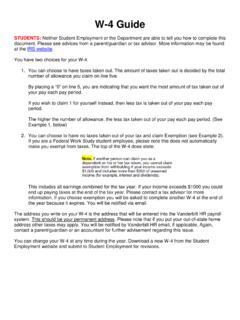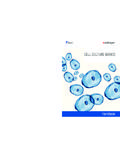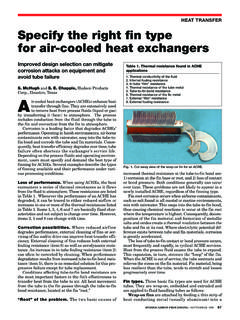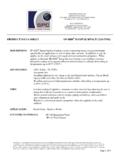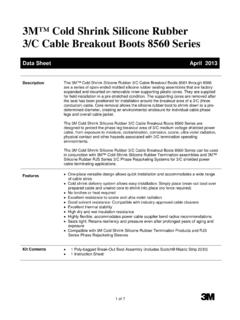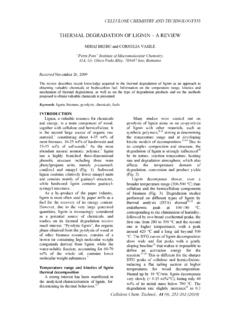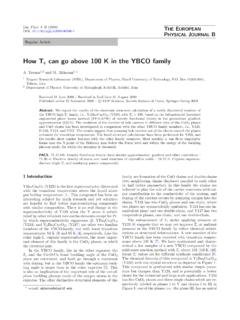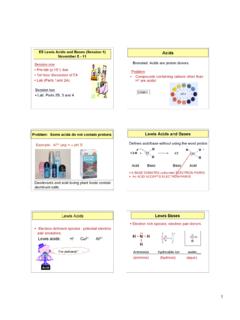Transcription of C-C BOND FORMATION 72 - Vanderbilt University
1 C-C bond FORMATION 72 Carbon- Carbon bond of enolates, enamines and hydrazonesC&S: Chapt. 1, , problems Ch 1: 1; 2; 3, 7; 8a-d; 9; 14 Ch. 2: 1; 2; 4)Smith: Chapt. of heteroatom stabilized anions C&S :Chapt. - ) Smith: Chapt. ReagentsC&S: Chapt. 7, 8, 9 problems ch 7: 1; 2; 3, 6; 13 Ch. 8: 1; 2 Smith: Chapt. Rearrangements . C&S Chapt. , , # 1e,f,h,op Smith Chapt. , Organic Synthesis 1991, vol. 2, -deprotonation of a ketone, aldehyde or ester by treatment with a strong non-nucleophillic carbonyl group stabilizes the resulting negative :ROHH-RO -HH- Base is chosen so as to favor enolate FORMATION . Acidity of C-H bond must be greater(lower pKa value) than that of the conjugate acid of the base (C&S table , pg 3)H3 CCH3 OpKa = 20 MeO- pKa = 15tBuO- pKa = 19unfavorable enolateconcentrationH3 CCH2 OOEtOpKa = 10more favorable enolate concentration- Common bases: NaH, EtONa, tBuOK, NaNH2, LiNiPr2, M N(SiMe3)2,Na CH2S(O)CH3 Enolate FORMATION :- H+ Catalyzed (thermodynamic)OH+OH- Base induced (thermodynamic or kinetic)OH:BO -+B:HRegioselective Enolate FormationTetrahedron 1976, 32, Kinetic enolate- deprotonation of the most accessable proton (relative rates ofdeprotonation).
2 Reaction done under essentially irreversible , THF, -78 CO - Li+C-C bond FORMATION 73typical conditions: strong hindered (non-nucleophilic) base such as LDAR2NH pKa= ~30 NLiEster Enolates- Esters are susceptible to substitution by the base, even LDA can beproblematic. Use very hindered non-nucleophillic base (Li isopropylcyclohexyl amide)ROOR'LDA, THF, -78 CE+RONROOR'THF, -78 CNLiO- Li+OR'R- Thermodynamic Enolate- Reversible deprotonation to give the most stable enolate:more highly substituted C=C of the enol formOtBuO- K+, tBuOHO - K+O - K+kineticthermodynamictypical conditions: RO- M+ in ROH , protic solvent allows reversible enolateformation. Enolate in small concentration (pKa of ROH= 15-18 range)- note: the kinetic and thermodynamic enolate in some cases may be the same- for , -unsaturated ketonesOthermodynamicsitekinetic siteTrapping of Kinetic Enolates- enol acetatesPhO1) NaH, DME2) Ac2 OkineticPhOOPhOO+isolatableseparate & purifyCH3Li, THFCH3Li, THFPhO- Li+PhO- Li+Regiochemicallypure enolatesC-C bond FORMATION 74- silyl enolethersSynthesis 1977, Chem.
3 Res. 1985, 18, ) LDA2) Me3 SiClkineticPhOTMSPhOTMS+isolatablesepara te & purifyCH3Li, THF-or-Bu4NF -or- TiCl4CH3Li, THFPhO- M+PhO- M+Geometricallypure enolates- tetraalkylammonium enolates- "naked" enolates- TMS silyl enol ethers are labile: can also use Et3Si-, iPr3Si- Silyl enol ether FORMATION with R3 SiCl+ Et3N gives thermodyanamic silyl enol ether- From EnonesO1) Li, NH32) TMS-ClTMSOH1) MeLi2) E+OHEOOSiMe3 OSiMe3 TMS-Cl, Et3 NTMS-OTfEt3 NOOSiMe3Li, NH3, tBuOHTMS-Cl- From conjugate (1,4-) additionsO(CH3)2 CuLiO- Li+E+OETrap or use directly- From reduction of -halo carbonylsOBrZn or MgO- M+Alkylation of Enolates (condensation of enolates with alkyl halides and epoxides)Comprehensive Organic Synthesis 1991, vol. 3, alkyl halides, allylic and benzylic halides work well2 alkyl halides can be troublesome3 alkyl halides don't workC-C bond FORMATION 75Oa) LDA, THF, -78 Cb) MeIOMe- Rate of alkylation is increased in more polar solvents (or addition of additive)(Me2N)3 POHMPARNMe2OR= H DMFR-CH3 DMAH3 CSCH3 ODMSOCH3 NOCH3 NNCH3 OMe2 NNMe2 TMEDAM echanism of Enolate Alkylation: SN2 reaction, inversion of electrophile stereochemistryM+ -OXC180 Alkylation of 4-t-butylcyclohexanone:ORORE equitorial anchorO- M+HtBuREEABHtBuEROAB favoredOREHtBuChairTwist Boaton cyclohexanone enolates, the electrophile approaches from an "axial" trajectory.
4 Thisapproach leads directly into a chair-like product. "Equitorial apprach leads to a higherenergy twist-boat of , -unsaturated carbonylsOR1HR2HO- M+R1R2HO- M+R1HR2 KineticThermodynamicOR1ER2 HOR1HR2 EEEC-C bond FORMATION 76 Stork-Danheiser Enone Transposition:- overall -alkylation of an , -unsaturated ketoneOMeOLDAPhCH2 OCH2 ClOMeOPhOCH3 LiOMeHOPhOCH3 OCH3 PhOH3O+J. Org. Chem. 1995, 60, enolates- Chiral Evans JACS 1982, 104 , 1737; Aldrichimica Acta 1982,15 , Synthesis 1984, 3, N-Acyl oxazolidinonesNOROOMePhMePhH2 NOHnorephedrineNOROOH2 NOHvalinolNOROOMePhNOROOLDA, THFEt-INOROOMePhmajor product (96:4)OHROLiOH, H2O, THFLDA, THFEt-INOROO major product (96:4)OHROLiOH, H2O, THFC omplimentary Methodsfor enantiospecific alkylationsDiastereoselectivity: 92 - 98 %for most alkyl halidesEnolate OxidationChem. Rev. 1992, 92, (SiMe3)2,THF, -78 CNOPhSO2 PhRNOOOOH(88 - 98 % de)LDA, THFOtBuONNOtBuORNOOONBocHNBoc(94 - 98 % de)1) HO-2) CH2N23) TFA4) Raney NiROMeONH2C-C bond FORMATION 77 RNOOOPhBu2 BOTf, Et3 NRNOOOPhBBuBuNBSRNOOOPhBrN3-RNOOOPhN31) LiOH2) H2, Pd/CROHONH2D- amino acidsRNOOOPhKN(SiMe3)2, THFSO2N3 RNOOOPhN3 Oppolzer Camphor based auxillariesTetrahedron, 1987, 43, on the order of 50 : 1 NOOSO2 PhRArNSO2 PhOOArROORSO2N(C6H11)2SO2 NOROOSO2N(C6H11)2Et2Cu BF3 OOSO2N(C6H11)2 HLDA, NBSOOSO2N(C6H11)2 HBrHOOHNH2 Asymmetric Acetate AldolNOOSNH2 OHBrO1)Sn(OTf)2, CH2Cl2, R3N, -40 C2) TIPS-OTf, pyridine3) NH3 BrTIPSO85 %, 19:1 deJ.
5 Am. Chem. Soc. 1998, 120, 591J. Org. Chem. 1986, 51, 2391 Chiral lithium amide basessMeOOMeCO2 EtCH3 PhNOMeLiTHF, -78 C(CH3)2C=OMeOOMeCH3OO(72% ee)C-C bond FORMATION 78tBuO N N NLiPhTHF, HMPATMSCltBuOTMS(97 % ee)ButOHHLiNNPhNMeLewis Acid Mediated Alkylation of Silyl Enolethers- SN1 like alkylationsOTMStBu-Cl, TiCl4,CH2Cl2, -40 C(79%)OCH3C(CH3)3note: alkylation with a 3 alkyl halideOTMSTiCl4, CH2Cl2, -40 C(78%)SPhRClORSPhRaney NiOR(95 %)ACIEE1978, 17, 48TL 1979, 1427 EnaminesGilbert StorkTetrahedron 1982, 38, 1975, Advantages: mono-alkylation, usually gives product from kinetic enolizationNNOO"Kinetic""Thermodynamic"c an not become coplanarONHOH+, (-H2O)NOenamine R-INOR+H2 OOE-Chiral enaminesNEOI mines Isoelectronic with ketonesNOMePhLDA, THF, -20 CNPhMeOLi1) E2) H3O+OEE = -CH3, -Et, Pr, PhCH2-, allyl-ee 87 - 99 %C-C bond FORMATION 79 Hydrazonesisoelectronic with ketonesComprehensive Organic Synthesis 1991, 2, 503OH+, (-H2O)Me2N-NH2 NNLDA, THFNN-NN-E+NNEhydrolysisOE- Hydrazone anions are more reactive than the corresponding ketone or Drawback: can be difficult to Chiral hydrazones for asymmetric alkylations (RAMP/SAMP hydrazones- D.
6 Enders"Asymmetric Synthesis" vol 3, chapt 4, Academic Press; 1983)NNH2 OMeNH2 NMeOSAMPRAMPNNOMeLDAIOTBSNNOMeTBSOO3 OTBSOH(95 % de)NNOMe1) LDA2) Ts-CH3, THF -95 - -20 C3) MeI, 2N HClOCH3(100 % ee)NR2HR1 NMeOLiZ (C,N)E (C,C)ENR2HR1 NMeOE Aldol CondensationComprehensive Organic Synthesis 1991, 2, 133, ) LDA, THF, -78 Cb R'CHOHORR'OH -hydroxyl aldehyde (aldol)- The effects of the counterion on the reactivity of the enolates can be importantReactivity Li+ < Na+ < K+ < R4N+addition of crown ethersC-C bond FORMATION 80- The aldol reaction is an equilibrium which can be "driven" to 'O- M++RCHOHORR'OMHORR'OHwork-upIn the case of hindered enolates, the equillibrium favors reactants. Mg2+ and Zn2+counterions will stabilize the intermediate -alkoxycarbonyl and push the equillibriumtowards products. (JACS 1973, 95, 3310)O- M+PhCHO, THFOPhOHM= Li 16% yieldM= MgBr 93% yield- Dehydration of the intermediate -alkoxy- or -hydroxy ketone can also serve to drivethe reaction to the Na +, tBuOHOOHOJACS 1979, 101 , 1330 OEnolate Geometry- two possible enolate geometriesOLDA, THF, -78 CO - Li+O - Li++E - enolateZ - enolateHH- enolate geometry plays a major role in (anti)erythro (syn)E-enolateR3 CHO-enolateZR1R2 OMHR2OR1R3 OHR2 OMHR1R1OR2R3 OHR3 CHO- Zimmerman-Traxler Transition State.
7 Ivanov condensationJACS 1957, 79 , +--+"pericyclic" MgBr+PhHOOOMgHPhPhHOMgBrBrC-C bond FORMATION 81 Analysis of Z-enolate stereoselectivityerythro (syn)favoredR3HR1 HOMOR2 OMOR2HR1HR3R1 OMOR3 HHR2R2OR1R3 OHdisfavoredthreo (anti)R2HR3 HOOMR1HR3R1 HOMOR2 OMOR2HR1R3HR2OR1R3 OHAnalysis of E-enolate stereoselectivityerthro (syn)disfavoredfavoredthreo (anti)HR2HR3 OOMR1R3HR1R2 OMOHOMOHR2R1HR3HR3R1R2 OMOHR1 OMOHR3R2HR2OR1R3 OHR2OR1R3 OHHR3R1R2 OMOHA nalysis of Boat Transition State for Z-EnolatesR3HR1HR2 OMOHR3R1HR2 OMOOOMHR3R2HR1 OOMR3HR2HR1R1R3OR2 HOR1R3OR2 HOstaggeredFavored ChairBoatBoat: R1-R2 1,3-interaction is goneDisfavored ChairC-C bond FORMATION 82 Analysis of Boat Transition State for E-EnolatesR3HR1R2 HOMOHR3R1R2 HOMOOOMHR3HR2R1 OOMR3 HHR2R1R1R3OR2 HOR1R3OR2 HOstaggeredBoat: R1-R2 1,3-interaction is goneDisfavored ChairBoatFavored ChairSummary of Aldol Transition State Analysis:1. Enolate geometry (E- or Z-) is an important stereochemical aspect.
8 Z-Enolatesusually give a higher degree of stereoselection than Li+, Mg 2+, Al3+= enolates give comparable levels of diastereoselection for kineticaldol Steric influences of enolate substituents (R1 & R2) play a dominent role in M+ R1R2HO- M+ R1HR2OR1R2R3 HOOR1R2R3 HOPath APath APath BWhen R1 is the dominent steric influence, then path A proceeds. If R2 is the dominentsteric influence then path B The Zimmerman-Traxler like transition state model can involve either a chair or "Open" Transition State for non-Chelation Control AldolsAbsence of a binding counterion. Typical counter ions: R4N+, K+/18-C-6, Cp2Zr2+- Non-chelation aldol reactions proceed via an "open" transition state to give syn aldolsregardless of enolate Enolates:R1R2O -HOR3 HOR3 HHR2R1O -HR3OR2HO -R1OR1R3R2 HOSyn AldolR1R2O -HOHR3 OHR3HR2R1O -R3 HOR2HO -R1OR1R3R2 HOAnti AldolFavoredDisfavoredDisfavoredFavoredC -C bond FORMATION 83E- Enolate:- OR2R1 HOR3 HOR3 HHR2- OR1HR3OR2HR1- OOR1R3R2 HOSyn Aldol- OR2R1 HOHR3 OHR3HR2- OR1R3 HOR2HR1- OOR1R3R2 HOAnti AldolfavoredfavoreddisfavoreddisfavoredN MR Stereochemical constants (J) are a weighted average of various non H-bonded60 Syn AldolJAB = 2 - 6 HzOR1R3R2 HAOHBHOHAR2R3 HBOR1HR3 HAR2 HBOR1 OHHBHAR2 OHR3OR1 Anti AldolJAB = 1 - 10 Hznon H-bonded60 60 Boron Enolates:Comprehensive Organic Synthesis 1991, 2, 239.
9 Organic Reactions 1995, 46, 1;Organic Reactions 1997, 51, 1. OPPI 1994, 26, Alkali & alkaline earth metal enolates tend to be aggregates- complicatesstereoselection Boron enolates are monomeric and homogeneous- B-O and B-C bonds are shorter and stronger than the corresponding Li-O abd Li-Cbonds (more covalent character)- therefore tighter more organized transition of Boron Enolates:OR2B-XOBR2iPrEtNX= OTf, IR= Bu, 9-BBNC-C bond FORMATION 84 HHR2R1OR3N:BL2 OTf+_R1R2 OBL2Z-enolateR2 HHR1OR3N:BL2 OTf+_R1 OBEt2E-enolateR2OR 3 BROBR2 OSiMe3R2B-XOBR2+ Me3Si-XRON2R'3 BROBR'2R'Hooz ReactionDiastereoselective Aldol Condensation with Boron EnolatesPhOPhOBEt2pure Z-enolateRCHOPhROOBEt2100% Syn AldolR1R2 OBEt2Z-enolateR3 CHOR1R3OR2 OHgenerally > 95 : 5syn : antiR1 OBEt2E-enolateR3 CHOR1R3OR2 OHgenerally~ 75 : 25anti : synR2 Asymmetric Aldol Condansations with Chiral Evans et al. Topics in Stereochemistry, 1982, 13 , Li+ enolates give poor selectivity (1:1)- Boron and tin enolates give much improved selectivity1) Bu2 BOTf,EtNiPr2, -78 2) RCHO+-> 99:1 erythroRCHOBu2 BOTf,EtNiPr2, -78 NMeOOOOONOROHMeONOOBBuBuOMeOHXROOPhNOMeC -C bond FORMATION 85+++++RCHOONOBOLLBLLONOOORHOHOBONOLLROO OBNOLLOBLLONOORR preferred conformation_____OBLLHR3R2 HNOOOOBLLR3R2 HNOOR3 ONOOR3OR2 OHNOOR3OR2 OHFavoredDisfavoredOppolzer SultamNSO2OR2 NSO2OR2L2 BNSOR2R3 SnOO1) LDA2) Bu3 SnClR3 CHONSO2OR2 OHR3 NSO2OR2 OHR3R3 CHOC-C bond FORMATION 86 Chiral BoronStBuOwhen large, higher E-enolateselectivityBOTfiPrEt2N,PhCHO,-7 8 CStBuOPhOHStBuOPhOH+1 : 33(> 99 % ee)RSPhOSPhOPhOHRSPhOPhOHR+NSO2 ArArO2 SNBPhPhBriPrEt2N,PhCHO,-78 C> 95 : 5(> 95 % ee) In general, syn aldol products are achievable with high selectivity, anti aldols aremore difficultMukaiyama-Aldol- Silyl Enol Ethers as an enolate acid promoted condensation of silyl ketene acetals (ester enolate equiv.
10 Withaldehydes: proceeds via "open" transition state to give anti aldols starting from eitherE- or Z- , TiCl4,CH2Cl2, -78 CRCO2 EtOHCH3 RCO2 EtOHCH3+R= iPr (anti : syn) = 100 : 0 C6H11 94 : 6 Ph 75 : 25 OSiMe3 OEtRCHO, TiCl4,CH2Cl2, -78 CRCO2 EtOHCH3 RCO2 EtOHCH3+R= iPr (anti : syn) = 52 : 48 C6H11 63 : 37 Ph 67 : 33 Asymmetric Mukiayama Aldol:NMe2 OPhH3 COSiMe3 RCHO, TiCl4,CH2Cl2, -78 CRRcOHORRcOHO+(90-94% de)syn : anti = 85 : 15selectivity insenstivie to enolate geometryC-C bond FORMATION 87 OOSitBuMe2 NPhSO2 PhiPrCHO, TiCl4,CH2Cl2, -78 CRcOCH3HO96 % deanti : syn = 93 : 7 OOSitBuMe2SO2N(C6H11)2 RCHO, TiCl4,CH2Cl2, -78 CRcOCH3HO+ Syn productE-EnolateR= Ph % de= 90 anti : syn = 91 : 19 nPr 85 94 : 6 iPr 85 98 : 2Z-EnolateR= iPr % de= 87 anti : syn = 97 : 7 Mukaiyama-Johnson Aldol- Lewis acid promoted condensation of silyl enol ethers with acetals:OSiMe3 TiCl4 or SnCl4 RCHO or RCH(OR')2 CH2Cl2, -78 COOHRM ukaiyama-Johnson Aldolvia Ti or Sn enolateOOOOOTMSOOOOHOTiCl4, CHCl2, -78 COOCl4Ti+OOCl4Ti+OSiMe3 PhOTMS(78 %)TiCl4,(CH3)2C(OEt)2 PhOOEtFluoride promoted alkylation of silyl enol ethersAcc.


